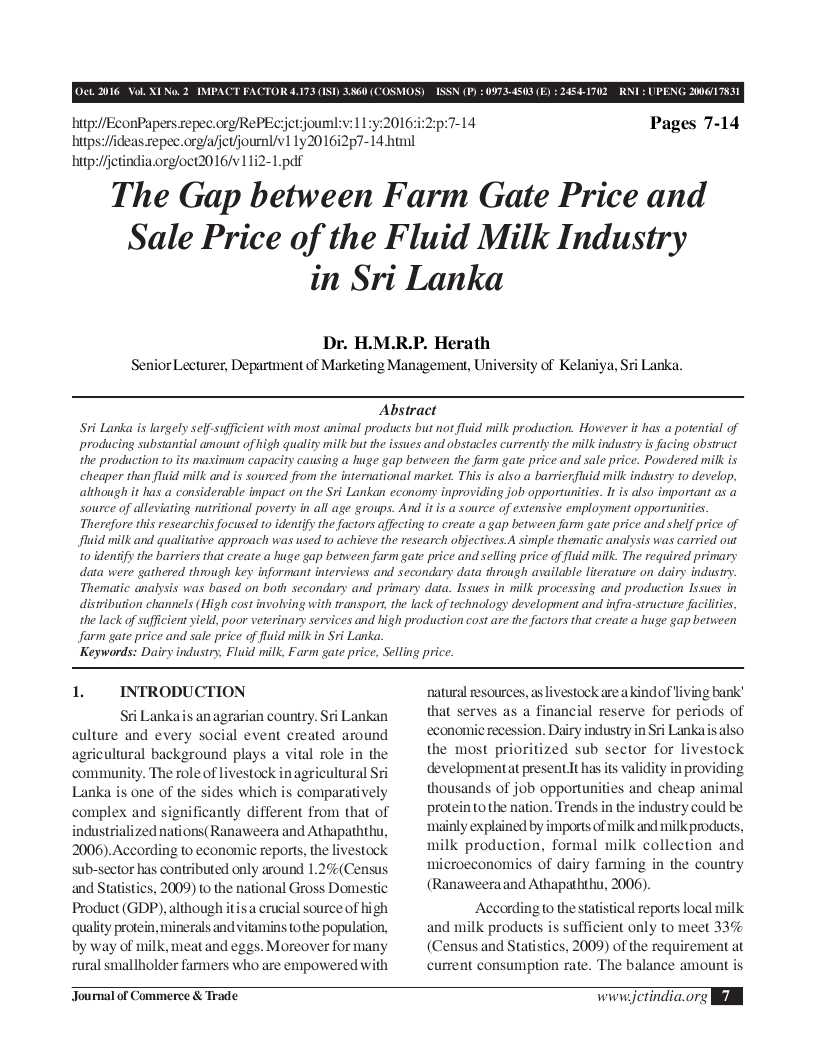The Gap Between Farm Price and Sale Price of the Fluid Milk Industry in Sri Lanka
DOI:
https://doi.org/10.26703/jct.v11i2.172Keywords:
Dairy Industry, Fluid Milk, Farm Gate Price, Sri LankaAbstract
Sri Lanka has a potential of producing substantial amount of high quality milk but the issues and obstacles currently the milk industry is facing obstruct the production to its maximum capacity causing a huge gap between the farm gate price and sale price. Powdered milk is cheaper than fluid milk and is sourced from the international market. This is also a barrier,fluid milk industry to develop, although it has a considerable impact on the Sri Lankan economy inproviding job opportunities. It is also important as a source of alleviating nutritional poverty in all age groups. And it is a source of extensive employment opportunities. Therefore this researchis focused to identify the factors affecting to create a gap between farm gate price and shelf price of fluid milk and qualitative approach was used to achieve the research objectives.A simple thematic analysis was carried out to identify the barriers that create a huge gap between farm gate price and selling price of fluid milk. The required primary data were gathered through key informant interviews and secondary data through available literature on dairy industry. Thematic analysis was based on both secondary and primary data. Issues in milk processing and production Issues in distribution channels (High cost involving with transport, the lack of technology development and infra-structure facilities, the lack of sufficient yield, poor veterinary services and high production cost are the factors that create a huge gap between farm gate price and sale price of fluid milk in Sri Lanka.
Downloads
Metrics
References
Ministry of livestock development (1996). Appraisal of Sri lanka dairy Sector. Peradeniya: Department of Animal Science,University of Peradeniya.
Burrior, W. (2005). Dairy Sector and External Environment. Journal of socio economic development, vol 5, pp 23-25.
E.D Jesse, B. C. (2008). Basic Milk pricing Concept for Dairy Farmers. University of Wisconsing.
Hossain. (2008). Difference between Commercial and Traditional Dairy Farm Management, Annal University of patronesia.
A. Joseph (2008). Key Informant Interview. In UCLA Center of Health Policy Research. UCLA.
M.N. Ibraham, S.J Staal, S.L Daniel, W.Thrope. (1999). Sri Lankan Daiy Sector Development, Journal of Socio ecnomic, vol 7.
The Vision for Future(2005). Mahinda Chinthanaya. Colombo.
Mohammed, .A.M Ahammed, Simeon Ethui, Yemaras Assefa. (2004, October). Dairy development in Ethiopa, Journal of Economic science, vol 3, pp 23-24.
NLDB. (2007). Dairy development Proiject. Colombo: Nationnal Live stock Development Board.
Ranaweera, Athapaththu. (2006). Sri lankan Dairy industry, Journal of Food Science, Vol 2, pp 12-13.
Rashid, M. (2004). Study on Contemparary practices of Dairy Industry. 12-14, Journal of Socio Science, vol 3, pp 21-30.
Department of Census and statistic. (2008). colombo: pp 5-21.
Agra (2007). The gap between producer prices and the prices paid by the consumer. CEAS .
DCS (2008). Annual Report. Colombo: Department of Census and Statistic.
CBS (2009). Annual Report. Colombo: Central Bank of Sri lanka.

Additional Files
Published
How to Cite
Issue
Section
License
Copyright (c) 2016 Journal of Commerce and Trade

This work is licensed under a Creative Commons Attribution 4.0 International License.







